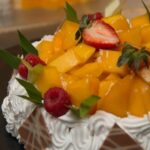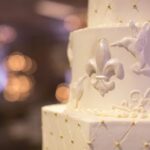Are you looking for a creative and budget-friendly way to decorate a cake? Look no further. In this article, we will explore how to decorate a cake with a knife, allowing you to achieve professional-looking designs without the need for expensive tools.
Cake decoration is an essential part of baking, as it adds visual appeal and enhances the overall experience of enjoying a delicious cake. While there are various tools commonly used in the art of cake decorating, we will focus on the versatility and effectiveness of using a knife to create beautiful designs and patterns on your cakes.
When it comes to cake decorating, the choice of tools can significantly impact the final result. From piping bags and spatulas to fondant cutters and stencils, there are countless gadgets and devices designed for creating intricate cake decorations.
However, using a simple kitchen knife can also yield impressive results. In this article, we will discuss the importance of cake decoration and explore the different tools commonly used in cake decorating, with a particular focus on the use of a knife as an essential tool for achieving stunning designs on your cakes.
In the following sections, we will provide valuable tips for selecting the best knife for cake decorating, as well as guidance on how to prepare the cake and icing for decorating. We will also walk you through basic knife techniques for spreading, smoothing, and creating texture on the cake.
Additionally, we will delve into advanced techniques such as layering and adding dimension to your designs using a knife. Get ready to elevate your baking game as we unveil the secrets of using a knife to decorate cakes like a pro.
Choosing the Right Knife
When it comes to cake decorating, selecting the right knife is crucial for achieving professional-looking designs. There are various types of knives available, each with its own unique features that make them suitable for different cake decorating techniques. The type of blade and handle play a significant role in the overall outcome of the decoration.
For intricate designs and detailed work, a small offset spatula or an angled palette knife is recommended. These knives have a thin, flexible blade that allows for precision when spreading icing and creating delicate patterns. On the other hand, a larger straight-edged knife works well for smoothing large surfaces and creating clean lines on the cake.
In addition to the blade, the handle of the knife is also an important factor to consider. A comfortable and ergonomic handle ensures better control and grip while decorating. It’s essential to choose a knife with a handle that feels comfortable in your hand and allows for easy maneuvering. Ultimately, selecting the best knife for cake decorating depends on personal preference and the specific design techniques you plan to use.
When choosing a knife for cake decorating, it’s important to consider the material of the blade as well. Stainless steel blades are durable and easy to clean, making them ideal for frequent use in cake decorating. Additionally, some decorators prefer non-stick blades to prevent icing from sticking while working on intricate designs. By carefully selecting the right knife based on its blade and handle features, decorators can enhance their skills in creating beautiful and professional-looking cake decorations.
Overall, choosing the right knife is essential for successful cake decorating. By understanding how different types of blades and handles work best with various design techniques, decorators can elevate their skills and create stunning cakes. Whether it’s spreading icing, creating intricate patterns, or adding finishing touches, having the appropriate knife can make all the difference in achieving flawless decorations on cakes.
Preparation
Decorating a cake with a knife is an art form that can transform a simple dessert into a stunning masterpiece. However, before you can begin using a knife to decorate your cake, it is crucial to properly prepare the cake and icing for decorating. This includes ensuring that the cake is level, applying a crumb coat, and chilling the cake to create a smooth surface for decorating.
First and foremost, it is important to ensure that your cake is leveled before you start decorating. Using a sharp knife, carefully trim off any domed top of the cake to create an even surface. This will not only make it easier to decorate the cake but will also result in a more professional-looking finished product.
Once the cake is leveled, it is time to apply a crumb coat. A crumb coat is an initial thin layer of icing applied to the cake to seal in any loose crumbs and create a smooth base for additional decorations. Using a knife, spread a thin layer of icing over the entire surface of the cake, making sure to cover any exposed areas thoroughly.
After applying the crumb coat, it is essential to chill the cake for at least 30 minutes before moving on to further decorations. Chilling the cake will help set the crumb coat and make it easier to add additional layers of frosting or decorations without creating crumbs or smudging the icing. Once chilled, your cake is now ready for smooth and easy decorating using various techniques with a knife.
Proper preparation of your cake and icing sets the foundation for successful decorating with a knife. By taking the time to level your cake, apply a crumb coat, and chill it before decorating, you can ensure that your finished product looks polished and professional.
Basic Knife Techniques
When it comes to decorating a cake, using a knife can be one of the most versatile and useful tools in your arsenal. Whether you’re spreading icing, smoothing the surface, or adding texture to your design, knowing how to use a knife effectively is crucial for achieving professional-looking results.
In this section, we will provide you with a step-by-step guide on using a knife to create basic decorating techniques such as spreading, smoothing, and creating texture on the cake.
Before you start decorating your cake with a knife, it’s essential to ensure that both the cake and the icing are properly prepared. Leveling the cake layers, applying a crumb coat, and chilling the cake are crucial steps to achieve a smooth and even surface for decorating. Once your cake is ready, you can begin by spreading an even layer of icing on top of each cake layer using a palette knife or offset spatula.
To achieve smooth edges and surfaces on your cake, use an icing smoother or bench scraper to gently press against the icing while turning the cake on its stand. This will help create clean lines and remove any excess icing. Additionally, to add texture and decorative elements to your design, you can use the tip of a small paring knife to create intricate patterns and designs in the icing.
Creating beautiful decorations with just a knife requires practice, patience, and precision. Experiment with different techniques such as dragging the tip of the knife through the icing for textured effects or using gentle strokes to spread and shape the icing smoothly. With practice, you’ll gain confidence in using a knife for cake decorating and develop your own unique style that will impress all who lay their eyes on your delicious creations.
| Technique | Description |
|---|---|
| Spreading | Evenly spread icing over each layer using a palette knife |
| Smoothing | Use an icing smoother or bench scraper to create clean lines and remove excess icing |
| Adding Texture | Create intricate patterns with the tip of a small paring knife for decorative effects |
Creating Designs
When it comes to cake decorating, using a knife can be a versatile tool for creating various designs and patterns on the cake. From simple flowers and geometric shapes to intricate details, there are several techniques that can be used to achieve stunning decorations. Here are some tips and tricks for using a knife to create eye-catching designs on a cake:
- Simple Flowers: To create simple flowers on a cake using a knife, start by piping small dots of icing in a circular pattern. Then, use a small knife to gently press and drag the icing from the center of the circle towards the outer edges. Repeat this process for each petal of the flower, adjusting the pressure and angle of the knife as needed to control the shape and size of the petals.
- Geometric Shapes: When creating geometric shapes such as squares, triangles, or diamonds on a cake, use a sharp kitchen knife to carefully cut out the desired shapes from rolled fondant or thinly spread icing. If you want to add dimension to the shapes, consider layering different colors or textures on top of each other using the same cutting technique.
- Intricate Details: For more intricate details like lace patterns or delicate filigree designs, use a small paring knife or pointed blade to carefully carve out intricate patterns directly onto fondant or buttercream icing. Take your time and work slowly with precision to achieve detailed and elegant decorations.
In addition to these specific design techniques, it’s important to remember that practicing with different types of knives and experimenting with various pressures and angles will help improve your skills in creating beautiful designs. Whether you’re aiming for whimsical decorations or sophisticated details, mastering these techniques will enhance your cake decorating abilities.
Keep in mind that patience is key when using a knife for cake decoration-do not rush through any step of the process. Taking your time and practicing consistently will eventually lead to exceptional results. The more you experiment with different designs and patterns using a knife, the better you will become at achieving professional-looking decorations on your cakes.
Remember that every mistake is an opportunity to learn, so don’t get discouraged if things don’t turn out perfect right away. With dedication and practice, you’ll be able to master the art of decorating cakes with a knife in no time.
Layering and Dimension
Adding layers and dimension to a cake design can truly elevate the overall look and feel of the dessert. Using a knife for this purpose requires precision and skill, but with practice, anyone can master this technique.
Creating 3D Effects
One way to add dimension to a cake is by creating 3D effects using a knife. This can be achieved by carefully carving out specific shapes or patterns on the surface of the cake. For example, you can create 3D flowers or leaves by gently etching out the details with a sharp knife. By varying the depth of your cuts, you can create a realistic and visually interesting design that will impress your guests.
Adding Depth to Decorations
Another technique for adding dimension to your cake design is by adding depth to your decorations. This can be done by layering different elements on top of each other, such as fondant cutouts or piped frosting details. By strategically placing these decorations at different depths on the cake, you can create a sense of depth and perspective that will make your design pop.
Practice Makes Perfect
It’s important to note that mastering these techniques takes time and practice. Experiment with different designs and patterns to see what works best for your cakes. Don’t be discouraged if your first few attempts don’t turn out as expected – with patience and persistence, you will improve your skills and create stunning layered and dimensional cake designs using just a knife.
By incorporating these layering and dimension techniques into your cake decorating repertoire, you’ll be able to take your designs to the next level and impress everyone with your professional-looking creations.
Finishing Touches
When it comes to adding the finishing touches to a cake, using a knife can be an essential tool for creating sharp edges, precise lines, and polished decorations. Here are some tips and techniques on how to use a knife for these final details:
- Sharp Edges: Achieving sharp edges on a cake can be done by using a long, flat-edged knife or an offset spatula. After applying the initial layer of icing, use the knife to smooth out any rough edges and create clean lines along the sides of the cake. This technique may require some practice and patience, but it can elevate the overall appearance of the cake.
- Precise Lines: To create precise lines and details on the cake, consider using a small paring knife or a decorating knife with a fine tip. With steady hands and controlled movements, you can carefully carve out intricate patterns, shapes, or even write messages on the cake’s surface.
- Polished Decorations: When adding decorative elements such as fondant cutouts or chocolate accents to the cake, a sharp knife is necessary for achieving clean and polished results. Take your time when cutting out these elements, ensuring that they are neatly trimmed and free from any jagged edges.
In addition to these tips, it’s important to keep your knife clean and free from any residue or crumbs as you work on adding these final details to the cake. A clean blade will help maintain the neatness and precision of your decorations.
Using a knife for adding finishing touches to a cake may require steady hands and attention to detail. Remember that practice makes perfect when it comes to mastering these techniques. Don’t be afraid to experiment with different knives and tools to find what works best for you when adding those last-minute details to your beautifully decorated cakes.
Troubleshooting
When decorating a cake with a knife, it’s important to be aware of common issues and mistakes that can occur during the process. By understanding how to fix and avoid these problems, you can achieve a professional-looking cake design. Here are some tips for troubleshooting when using a knife for cake decorating.
Inconsistent Icing Thickness
One common issue when decorating a cake with a knife is achieving inconsistent icing thickness. This can result in an uneven and unprofessional appearance on the finished cake. To avoid this problem, start by applying a thin crumb coat of icing to the entire cake. Then, use a long, straight-edged knife to carefully spread and smooth the icing in even layers. Take your time with this step, as it is crucial for creating a flawless finish on the cake.
If you do encounter inconsistent icing thickness while decorating, don’t worry – there’s a simple fix. Use your offset spatula or knife to scrape off any excess icing from areas where it is too thick. Then, carefully add more icing to areas that need it, ensuring that you maintain an even thickness throughout the entire surface of the cake.
Uneven Edges
Another common mistake when using a knife for cake decorating is creating uneven edges on the cake. This can happen if you apply too much pressure or angle your knife incorrectly while smoothing or shaping the icing. To avoid this issue, make sure to hold your knife at a consistent angle and use gentle, steady movements when working with the icing.
If you notice uneven edges on the cake while decorating, don’t panic – there’s an easy solution. Simply use your knife to gently reshape and smooth out any rough or uneven areas. Take your time with this step and work slowly and carefully until you achieve clean, sharp edges and smooth surfaces on the cake.
By being aware of these common issues and knowing how to fix and avoid them, you can improve your skills in using a knife for cake decorating. With practice and patience, you’ll be able to create professional-looking designs that will impress your family and friends at any celebration.
Conclusion
In conclusion, decorating a cake with a knife is an art form that requires patience, practice, and the right technique. As discussed in this article, choosing the right knife for cake decorating is crucial, as well as proper preparation of the cake and icing. Basic knife techniques are essential for spreading, smoothing, and creating texture on the cake, while creating designs and adding layers and dimension require skill and precision.
It’s important to remember that mastering the art of cake decorating with a knife takes time and practice. Experimenting with different designs and patterns, as well as learning how to troubleshoot common issues, will help improve your skills over time. The key is to not get discouraged by mistakes but rather see them as opportunities to learn and grow as a cake decorator.
Ultimately, the most important thing is to have fun with the process. Cake decorating can be a therapeutic and rewarding activity that allows for creativity and self-expression. So don’t be afraid to experiment and try new things when using a knife to decorate your cakes. With dedication and perseverance, you can achieve beautiful and professional-looking cake designs that will impress any audience.
Frequently Asked Questions
Can You Frost a Cake With a Knife?
Yes, it is possible to frost a cake with a knife. However, using a regular kitchen knife may not give you the smoothest or most professional-looking results. It’s important to use the right technique to achieve even frosting.
What Knife Is Best for Frosting a Cake?
The best knife for frosting a cake is actually an offset spatula. This type of knife has a bent handle that keeps your hand out of the way and gives you better control as you frost the cake. The flat, flexible blade also helps create a smooth surface.
How Do You Paint a Cake With a Palette Knife?
To paint a cake with a palette knife, start by ensuring that your frosting is at the right consistency – not too stiff or too runny. Then, use the palette knife to spread the frosting evenly over the cake in broad strokes or in a swirling motion for more texture and visual interest.

Welcome to my blog about home and family. This blog is a place where I will share my thoughts, ideas, and experiences related to these important topics. I am a stay-at-home mom with two young children. I hope you enjoy reading it! and may find some helpful tips and ideas that will make your home and family life even better!





